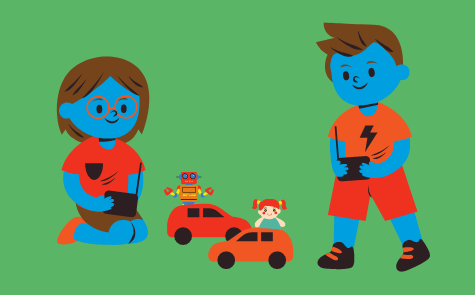4 Top Tips for Using Video to Advertise Toys

If I could capture a feeling in a bottle, it would be that sense of relief you got as a kid on the last day of school before holiday break. You knew the day would be filled with movies and seasonally-appropriate arts, crafts, and games that were far more fun than any boring old biology lesson. And hey, if you were really super lucky, you’d get a half-day to usher you into the sugarplum dreams that awaited us all at the end of the year.
As juicy as that feeling was, it didn’t hold a candle to the gut-spinning suspense you had waiting to open your first present of the holiday season. It doesn’t matter what you celebrate, the sense of anticipation every child has when a gift is in their hands is unparalleled. Sure, us grown-ups may sit on a few pins and needles waiting for the latest gaming console or iPhone to drop, but it doesn’t match the unbridled excitement a kid has from opening a present containing their most sought-after toy.
THE ONE MARKETING SOLUTION YOU NEED FOR 2022: Learn what Creative Analytics is, and why it’s the next frontier of data-driven marketing.
If you sell toys, especially during the holiday season, you understand how important it is to capture that feeling in your holiday video advertisements. You want to inspire that same feeling of excitement and anticipation in your ads that your target audience feels during the holidays.
Over the course of recent years, toy sales have boomed, increasing 16% in 2020 alone. Most advertisers will ramp up their toy advertising during the holiday seasons, but the higher demand for toys has caused them to scale their marketing and advertising efforts at a considerable pace. The access to multiple media outlets has also required advertisers to expand their toy advertising beyond the TV screen and onto online sites and social media platforms.
Learn More: Social Media Video Ad Specs & Placements Guide
First Things First: What Makes Toy Advertising Work?
Beyond the toys themselves, there are several key elements that make a toy ad effective. Though some of these elements have always been evident in toy commercials, many toy brands have incorporated new ideas or transformed old ones to appeal to new types of consumers.
1. Connecting With Emotions
Overall, children connect more with emotions than they do with any factual information or evidence. That’s why the majority of children’s advertisements often show other happy children at play, enjoying toys with their friends or family. This is especially true at a young age where children may not fully understand the purpose of advertisements and aren’t capable of differentiating between reality and fantasy on TV.
This video QuickFrame enabled Hasbro to create uses the emotion of family togetherness to inspire their target audience to act.
2. Appealing to Parents
Interestingly, there’s been an uptick in toy advertising that appeals to parents as well as children. Many advertisers have latched onto the nostalgia theme that has increased in recent years, bringing back favorite toys in new ways. Some of the most popular examples include Tamagotchi, Furby, and Polly Pocket. These ads can persuade parents to buy these toys once again — this time, to share with their children.
This video QuickFrame enabled Barnes & Noble to create is a great example of a video appealing directly to parents, because–as the first frame eludes to–it flat out tells them what toys they should buy.
3. Getting Social
Social media channels like YouTube are filled with toy-related videos from “toy influencers.” These influencers have millions of followers and share videos like toy unboxing and reviews. Tapping into influencer marketing not only appeals to eager viewers, but can also help circumvent data privacy changes that make social media marketing more challenging for advertisers.
4. Targeting Video Platforms
YouTube Kids is one social site that is made for children to use instead of adults. Many toy brands have gone beyond simply posting video advertisements, and have instead created entire YouTube mini-series dedicated to toy products, including Barbie and My Little Pony. Producing these kinds of video series makes for a more immersive experience with toys.
Top Toy Video Advertising Ideas and Tips
Effective toy advertisements not only use the right strategies but also incorporate various types of video techniques and formats. Some of the most popular video ideas and tips are:
Interactive Videos
Interactive videos are a particularly good idea for toy marketing, as adults and their children can get a feel for the toy on a virtual level. For instance, you can make an interactive toy video that allows viewers to click on different texts or graphics on the video. Each click can show more information about the toy or introduce viewers to its features. Interactive videos work best on your brand’s website or PDPs.
Tip: Ensure viewers can easily understand where to click so they don’t get confused. You can add a mini CTA below any link or graphic to help, including a phrase like “click here.”
Play-Along Videos
Lots of children see play-along videos at school, where teachers show clips that children can sing or dance along to. These videos are fun, encourage action, and can additionally be used for advertising. You can craft a video where children see another child playing with the toy, encouraging a particular kind of play or movement.
Tip: Add music, sound and visual effects, and bright colors to make the video both visually and auditorily engaging. Bright colors, in particular, draw in children and help them make sense of what they are seeing.
This ad that QuickFrame enabled Homer to create isn’t your typical video marketing example of a play-along video, but it does showcase the power these kinds of videos have. By showing your target audience what it looks like actually playing with your toy or game, they are allowed to vicariously feel like they’ve interacted with your product as well.
Media Carousels
If you have multiple video ideas, you can incorporate the use of a media carousel. When users click on a video on a web page, they will be shown an additional frame to see even more videos. This is a great idea if you want to showcase a toy that has multiple features or capabilities. Like with interactive videos, media carousels do well on PDPs.
Tip: Use a different format for each video. For instance, if your first video is a product demo, use UGC or a customer testimonial for the next to keep it interesting.
This ad that QuickFrame enabled Hollar to create shows the value of using media carousels–or giving the impression of media carousels–to illustrate multiple products, or their unique features.
Background Videos
If you want to integrate visuals but not center on any specific video, you can use background videos. Background videos play on a loop in the background of your site or PDP. These videos are usually short, about five or six seconds, and don’t use sound. They simply show your product or talent using your product as potential customers look through the page.
Tip: Keep background videos as simple as possible, including only one shot or frame. Otherwise, viewers might get too distracted or find the video to be a nuisance.
Brand Videos
If you’d rather focus on building brand awareness over featuring any specific product, you can make a video detailing your brand instead. For instance, you can create a video that gives a behind-the-scenes look at the toys you sell, including the creation process or perhaps the people behind the product. You can upload these marketing videos on YouTube or feature them on your social media pages.
Tip: A majority of consumers — 77% — buy from brands whose values are similar to their own. Consider sharing your brand values with your audience to tap into this desire and promote authenticity, which makes many brands stand out.
Alright, so this last video isn’t for a real toy, but it’s excellent at mimicking best practices of toy ads, nonetheless. This video that QuickFrame enabled DoorDash to create shows how they took a brand message, “it’s ok to play with your food,” and converted it into the language of a toy ad to position their food delivery service as fun, eccentric, and engaging.
Toy Video Advertising: Final Thoughts
Making use of the right toy advertisement strategies and video marketing ideas can lead to greater sales and deeper consumer trust in your brand. Remember, happiness and excitement work best with toy ads above all, no matter which kind of video you make.
NEED LAST MINUTE TIPS FOR HOLIDAY CAMPAIGNS: Download our free guide to holiday video marketing.
Do More with Video
Learn how we can help you produce more quality videos affordably and at scale.


